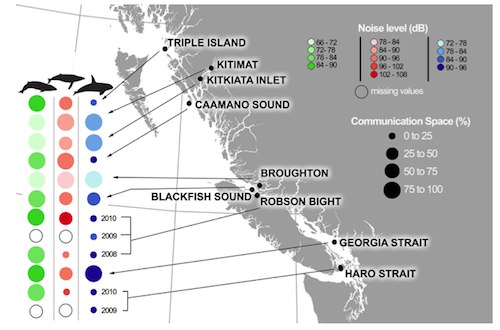New paper details the acoustic quality of critical whale habitats
Bioacoustics, Effects of Noise on Wildlife, Human impacts, Ocean, Shipping Comments Off on New paper details the acoustic quality of critical whale habitatsAEI lay summary of:
R. Williams, C.W. Clark, D. Ponirakis, and E. Ashe. Acoustic quality of critical habitats for three threatened whale populations. Animal Conservation (2013).
Innovative research along the coast of British Columbia has quantified the degree to which shipping noise is reducing the distance at which whale vocalizations can be heard. This is one of the first studies to use recordings of actual ocean noise levels to examine how the “communication space” of whales is affected by shipping noise in an area where whale conservation is a priority. Among its troubling findings is that endangered orcas are facing the highest levels of noise in areas that are legally designated as critical habitat, with communication space reduced to 25% or less even in average noise conditions; over the entire study region, the area over which orcas can hear each other can be reduced by 62% during average noisy conditions, and 97% during the noisiest times. Humpback whales face nearly as large reductions in some key areas (though not formally designated critical habitat; and, notably, are showing signs of a tenuous recovery in some of the areas studied), while fin whales, who have louder calls than the other species, are only mildly affected by shipping noise.
 (noise levels and communication space in median noise conditions)
(noise levels and communication space in median noise conditions)
Communication space (alternatively termed “effective listening area”) is a relatively recent introduction into scientific parlance; it’s a measure of the area within which a particular species can hear and be heard by others of its kind; both marine and terrestrial bioacousticians have begun using this framework to better understand the ways animals may be affected by increased background noise introduced by human activities, including shipping, roads, and airplane overflights. Previously, small increases in background noise were commonly considered to cause only negligible impacts, since there is rarely a clear or consistent behavioral reaction. However, many animals rely on hearing things at the edges of audibility (calls of their kin, the approach of predators, the presence of prey), and a significant reduction in an animal’s communication space can cause a need to use more energy hunting, or to be in a heightened state of alertness (and stress) to avoid predation.

 For the first day and a half, larvae exposed to airgun noise showed significant developmental delays. At close to two days, the noise-exposed group appeared to be nearly as likely to be fully developed as the control group (upper right chart). But, after passing the 48-hour mark, as the larvae moved into the next stage of development, those in noise lagged again; at 66 hours, all of the control larvae had completed the D-veligar development, while a large proportion of those exposed to noise did not complete this transition. In addition, a significant proportion of the noise-exposed larvae began exhibiting physical abnormalities (localized bulges in the soft body of the larvae, but not in the shell). By the end of the study, at 90 hours, an average of 46% of noise-exposed larvae showed malformations, ranging from 27%-91% in the four flasks being independently analyzed. (Ed. Note: I’ve reproduced five of the seven charts here, omitting samplings at 54hrs and 90hrs for the sake of better readability.)
For the first day and a half, larvae exposed to airgun noise showed significant developmental delays. At close to two days, the noise-exposed group appeared to be nearly as likely to be fully developed as the control group (upper right chart). But, after passing the 48-hour mark, as the larvae moved into the next stage of development, those in noise lagged again; at 66 hours, all of the control larvae had completed the D-veligar development, while a large proportion of those exposed to noise did not complete this transition. In addition, a significant proportion of the noise-exposed larvae began exhibiting physical abnormalities (localized bulges in the soft body of the larvae, but not in the shell). By the end of the study, at 90 hours, an average of 46% of noise-exposed larvae showed malformations, ranging from 27%-91% in the four flasks being independently analyzed. (Ed. Note: I’ve reproduced five of the seven charts here, omitting samplings at 54hrs and 90hrs for the sake of better readability.)